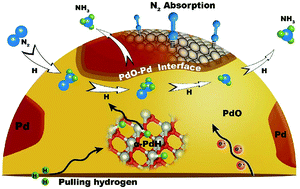Construction of PdO–Pd interfaces assisted by laser irradiation for enhanced electrocatalytic N2 reduction reaction†
Abstract
Due to the strong absorbability and excellent activating ability of palladium (Pd) element for N2, Pd-based materials have become one of the most promising catalysts for electrocatalytic N2 reduction reaction (NRR) applications, which is a low-cost and ecofriendly way for ammonia synthesis under ambient conditions. However, the lack of active sites and poor stability are still the major issues that restrain their catalytic activity. To solve these problems, PdO/Pd heterojunctions supported on carbon nanotubes (PdO/Pd/CNTs) with a controllable mass ratio of Pd to PdO were fabricated using ultraviolet laser irradiated PdO/CNTs in distilled water. Compared with PdO/CNTs, PdO/Pd/CNTs, especially the ten minutes irradiated one, present an optimal mass ratio of Pd (18%) to PdO (82%) and abundant PdO–Pd interfaces which can act as active sites for N2 dynamic activation and proton transitions, where the synergistic effect of Pd and PdO contributed to shorten the transmission route of protons and reduce the overpotential of the chemical reaction. Thus, the N2 conversion efficiency of PdO/Pd/CNTs was obviously improved, their faradaic efficiency reached up to 11.5% and NH3 yield was 18.2 μg mgcat.−1 h−1 at 0.1 V vs. RHE. Besides, this work will provide useful reference to design NRR catalysts with controllable surface states and defects by laser-assisted strategies.



 Please wait while we load your content...
Please wait while we load your content...